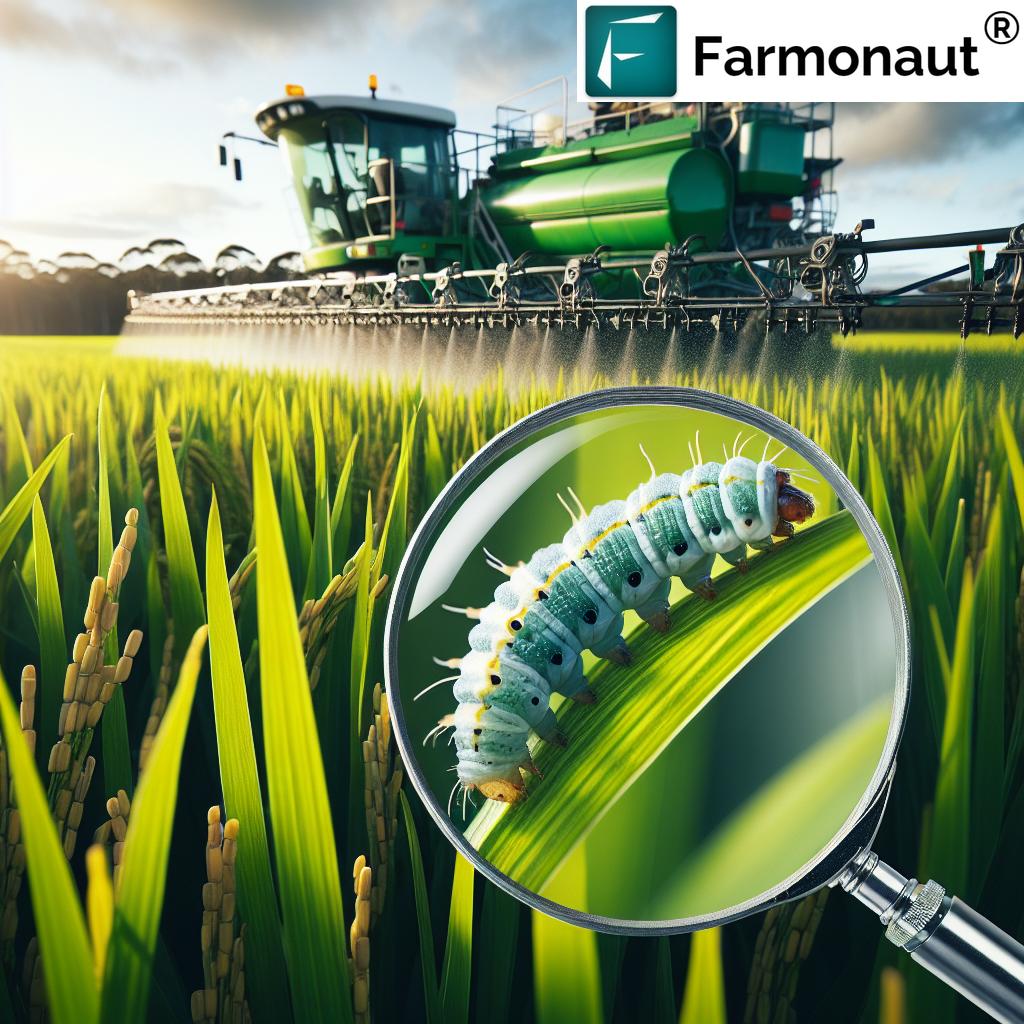Sustainable Agriculture: Balancing Neonicotinoid Use and Environmental Protection in Australian Grain Farming

“Australian grain farmers have reduced neonicotinoid use by up to 30% through integrated pest management techniques.”
In the ever-evolving landscape of Australian agriculture, we find ourselves at a critical juncture where the balance between effective crop protection and environmental stewardship has never been more crucial. As we delve into the complexities of sustainable agriculture practices and the use of neonicotinoid insecticides in farming, we uncover a narrative that speaks to the heart of the Australian grain industry’s future.
Our journey through this comprehensive exploration will take us from the sun-baked fields of rural Australia to the cutting-edge laboratories where agricultural innovation thrives. We’ll examine how the delicate equilibrium between neonicotinoid use and environmental protection is shaping the future of grain production in our country.
The Australian Grain Industry: A Cornerstone of National Agriculture
The Australian grain industry stands as a pillar of our agricultural sector, contributing significantly to both domestic food security and export markets. Our vast landscapes are dotted with golden wheat fields, shimmering canola crops, and robust barley plantations. These grains not only feed our nation but also play a crucial role in global food supply chains.
However, with great production comes great responsibility. The challenges faced by our grain farmers are multifaceted:
- Unpredictable weather patterns
- Evolving pest pressures
- Market volatility
- Increasing environmental regulations
At the heart of these challenges lies the ongoing debate surrounding neonicotinoid insecticides – a class of chemical pesticides that have been both a boon and a bane for agriculture worldwide.
Neonicotinoids: A Double-Edged Sword in Crop Protection
Neonicotinoid insecticides have revolutionized pest control in grain farming since their introduction. These systemic pesticides, which are absorbed by plants and distributed throughout their tissues, offer effective protection against a wide range of insect pests. Their popularity among Australian farmers stems from their efficacy and relatively low mammalian toxicity compared to older pesticide classes.
However, the widespread use of neonicotinoids has not been without controversy. Concerns about their impact on non-target organisms, particularly pollinators like bees, have led to scrutiny and regulatory restrictions in many parts of the world, including Australia.
The Environmental Conundrum
The environmental impact of neonicotinoids extends beyond their immediate application area. These chemicals can persist in soil and water, potentially affecting ecosystems far removed from agricultural fields. The debate surrounding their use has intensified as research continues to unveil the complex interactions between these pesticides and the environment.
Key environmental concerns include:
- Pollinator health and population decline
- Soil and water contamination
- Effects on aquatic ecosystems
- Potential impacts on bird populations
As stewards of the land, Australian grain farmers are acutely aware of these issues and are actively seeking ways to balance effective pest control with environmental responsibility.
Regulatory Landscape: Navigating the Complexities
The use of neonicotinoids in Australian agriculture is subject to a complex regulatory framework. The Australian Pesticides and Veterinary Medicines Authority (APVMA) plays a pivotal role in assessing and regulating agricultural chemicals, including neonicotinoids.
Recent years have seen a tightening of regulations surrounding neonicotinoid use, reflecting growing environmental concerns and aligning with international trends. These regulations aim to strike a balance between supporting agricultural productivity and safeguarding environmental health.
Key Regulatory Measures
- Restrictions on application methods to reduce drift
- Limitations on use during flowering periods to protect pollinators
- Mandatory buffer zones near water bodies
- Enhanced labeling requirements for neonicotinoid products
These measures have prompted Australian grain farmers to reassess their pest management strategies and explore alternative approaches to crop protection.
Sustainable Agriculture Practices: A Path Forward
In response to regulatory changes and environmental concerns, the Australian grain industry has been at the forefront of adopting sustainable agriculture practices. These practices aim to reduce reliance on chemical inputs while maintaining or improving crop yields.
Integrated Pest Management (IPM)
IPM has emerged as a cornerstone of sustainable pest control in grain farming. This holistic approach combines various strategies to manage pest populations effectively while minimizing environmental impact.
Key components of IPM in Australian grain farming include:
- Regular monitoring of pest populations
- Use of pest-resistant crop varieties
- Biological control methods
- Cultural practices such as crop rotation and timing of planting
- Targeted use of chemical pesticides as a last resort
By implementing IPM strategies, many Australian grain farmers have successfully reduced their reliance on neonicotinoids while maintaining crop health and productivity.
Precision Agriculture Technologies
The advent of precision agriculture has revolutionized the way Australian grain farmers approach pest management and resource use. These technologies enable more precise application of inputs, including pesticides, reducing overall chemical use and minimizing environmental impact.
Farmonaut, a leading agricultural technology company, offers advanced satellite-based farm management solutions that are particularly relevant in this context. Their platform provides real-time crop health monitoring and AI-based advisory systems, enabling farmers to make data-driven decisions about pest management and resource allocation.
Key precision agriculture technologies employed in Australian grain farming include:
- GPS-guided machinery for precise pesticide application
- Drone and satellite imagery for early pest detection
- Variable rate technology for optimized input use
- Soil sensors for monitoring moisture and nutrient levels
These technologies not only improve the efficiency of pest control but also contribute to overall farm sustainability by optimizing resource use.
The Role of Innovation in Sustainable Grain Farming
Innovation plays a crucial role in the ongoing efforts to balance neonicotinoid use with environmental protection in Australian grain farming. From novel pest control methods to advanced crop protection strategies, the industry is continuously evolving to meet the challenges of sustainable agriculture.
Biopesticides and Natural Alternatives
The development and adoption of biopesticides represent a promising avenue for reducing reliance on synthetic chemicals like neonicotinoids. These naturally derived substances offer effective pest control with minimal environmental impact.
Examples of biopesticides gaining traction in Australian grain farming include:
- Microbial pesticides derived from bacteria or fungi
- Plant-based insecticides
- Pheromone traps for pest monitoring and control
While biopesticides may not entirely replace neonicotinoids in all situations, they offer a valuable tool in the integrated pest management toolkit.
Genetic Innovation and Crop Resilience
Advances in plant breeding and genetic technologies are leading to the development of grain varieties with enhanced pest resistance. These innovations reduce the need for chemical interventions, including neonicotinoids, while maintaining crop yields.
Key areas of genetic innovation in Australian grain farming include:
- Marker-assisted breeding for pest-resistant traits
- Gene editing techniques for improved crop resilience
- Development of drought-tolerant varieties to reduce stress-induced pest susceptibility
By harnessing these genetic innovations, Australian grain farmers can further reduce their reliance on chemical pesticides while ensuring robust and productive crops.
The Global Context: Australia’s Role in Sustainable Agriculture
Australia’s approach to balancing neonicotinoid use and environmental protection in grain farming does not exist in isolation. As a major player in the global grain market, our practices and policies have far-reaching implications and are influenced by international trends and standards.
International Perspectives on Neonicotinoid Use
The global landscape of neonicotinoid regulation is diverse, with different countries adopting varying approaches:
- The European Union has imposed significant restrictions on neonicotinoid use
- The United States maintains a more permissive stance, with ongoing reviews
- Canada has implemented phased restrictions on certain neonicotinoids
Australia’s balanced approach, emphasizing responsible use and ongoing assessment, positions us as a leader in sustainable agricultural practices.
Export Market Considerations
As a significant grain exporter, Australia must navigate the complex requirements of international markets. Many importing countries have strict regulations regarding pesticide residues, including neonicotinoids.
Key considerations for Australian grain exporters include:
- Adherence to Maximum Residue Limits (MRLs) set by importing countries
- Certification of sustainable farming practices
- Traceability and transparency in pesticide use
These market demands further incentivize the adoption of sustainable pest management practices in Australian grain farming.
The Future of Neonicotinoid Use in Australian Grain Farming
As we look to the future, the path forward for neonicotinoid use in Australian grain farming is one of continued evolution and adaptation. The industry is poised to embrace a more holistic and sustainable approach to pest management, driven by a combination of regulatory pressures, environmental concerns, and technological advancements.
Emerging Trends and Predictions
- Increased adoption of IPM strategies across the grain industry
- Further integration of precision agriculture technologies in pest management
- Development of more targeted and environmentally friendly neonicotinoid formulations
- Greater emphasis on farmer education and training in sustainable pest control practices
- Continued research into the long-term impacts of neonicotinoids on ecosystems
These trends point towards a future where neonicotinoids, while still a part of the pest management toolkit, play a more limited and strategic role in Australian grain farming.
Collaborative Efforts for Sustainable Agriculture
Achieving a balance between effective pest control and environmental protection requires a collaborative effort from all stakeholders in the grain industry. Farmers, researchers, policymakers, and technology providers must work together to develop and implement sustainable solutions.
The Role of Research and Development
Ongoing research is crucial for informing best practices in neonicotinoid use and developing alternative pest control strategies. Australian research institutions and agricultural organizations are at the forefront of this effort, conducting studies on:
- Long-term ecological impacts of neonicotinoids
- Efficacy of alternative pest control methods
- Economic implications of reduced neonicotinoid use
- Development of pest-resistant crop varieties
This research provides valuable insights that guide policy decisions and farming practices.
Farmer Education and Support
Empowering farmers with knowledge and resources is essential for the successful implementation of sustainable pest management strategies. Initiatives focused on farmer education and support include:
- Workshops and training programs on IPM techniques
- Demonstration farms showcasing sustainable practices
- Online resources and decision support tools
- Peer-to-peer learning networks
By providing farmers with the tools and knowledge they need, we can accelerate the adoption of sustainable practices across the grain industry.
The Role of Technology in Sustainable Grain Farming
Technology plays a pivotal role in the transition towards more sustainable grain farming practices in Australia. Advanced tools and platforms are enabling farmers to make more informed decisions about pest management and resource allocation, reducing the need for broad-spectrum pesticides like neonicotinoids.
Satellite-Based Farm Management Solutions
Satellite technology has revolutionized the way farmers monitor and manage their crops. Platforms like Farmonaut provide real-time insights into crop health, allowing for early detection of pest infestations and targeted interventions.
Key benefits of satellite-based farm management include:
- Early detection of crop stress and pest pressure
- Optimization of pesticide application timing and dosage
- Improved resource allocation and farm planning
- Enhanced sustainability through data-driven decision making
By leveraging these technologies, Australian grain farmers can significantly reduce their reliance on neonicotinoids while maintaining crop health and productivity.
AI-Powered Advisory Systems
Artificial Intelligence (AI) is transforming pest management in grain farming. AI-powered advisory systems, such as Farmonaut’s Jeevn AI, analyze vast amounts of data to provide personalized recommendations for pest control and crop management.
These systems offer:
- Predictive pest modeling based on weather patterns and historical data
- Customized treatment recommendations that prioritize non-chemical interventions
- Real-time alerts for potential pest outbreaks
- Integration with precision application technologies for targeted pesticide use
The adoption of AI-driven pest management strategies represents a significant step towards reducing overall pesticide use, including neonicotinoids, in Australian grain farming.
Economic Implications of Sustainable Pest Management
The transition to more sustainable pest management practices, including reduced reliance on neonicotinoids, has significant economic implications for Australian grain farmers. While there may be short-term costs associated with adopting new technologies and practices, the long-term benefits are substantial.
Cost-Benefit Analysis
A comprehensive cost-benefit analysis of sustainable pest management practices reveals:
- Reduced input costs through more targeted pesticide use
- Improved crop resilience and potential yield increases
- Enhanced market access due to compliance with stringent international standards
- Potential price premiums for sustainably produced grains
- Long-term cost savings from improved soil health and ecosystem services
While the initial investment in sustainable practices and technologies may be significant, the long-term economic benefits make it a sound strategy for Australian grain farmers.
Government Support and Incentives
Recognizing the importance of sustainable agriculture, various government initiatives support the transition away from heavy reliance on neonicotinoids:
- Grants for implementing IPM strategies
- Tax incentives for investing in precision agriculture technologies
- Research funding for sustainable pest management solutions
- Extension services providing expert advice on sustainable farming practices
These support mechanisms help offset the costs of transitioning to more sustainable pest management approaches, making it more feasible for farmers to adopt these practices.
Case Studies: Success Stories in Sustainable Grain Farming
Across Australia, numerous grain farmers have successfully implemented sustainable pest management strategies, reducing their reliance on neonicotinoids while maintaining or improving crop yields. These case studies serve as valuable examples for the broader industry.
Integrated Pest Management Success
A large-scale wheat farm in Western Australia implemented a comprehensive IPM program, resulting in:
- 70% reduction in neonicotinoid use over three years
- 15% increase in beneficial insect populations
- Stable crop yields with reduced input costs
- Improved soil health and biodiversity on the farm
Technology-Driven Pest Management
A family-owned grain operation in Victoria leveraged precision agriculture technologies to optimize pest control:
- Implemented satellite-based crop monitoring and AI advisory systems
- Achieved 40% reduction in overall pesticide use, including neonicotinoids
- Reported 10% increase in crop yields due to more timely and targeted interventions
- Gained access to premium markets due to sustainable farming certification
These success stories demonstrate the viability and benefits of transitioning to more sustainable pest management practices in Australian grain farming.
Challenges and Opportunities in Sustainable Grain Farming
While the benefits of sustainable pest management practices are clear, the transition is not without its challenges. Australian grain farmers face several obstacles in reducing their reliance on neonicotinoids and adopting more sustainable approaches.
Key Challenges
- Initial costs of implementing new technologies and practices
- Knowledge gap in managing pests without heavy reliance on neonicotinoids
- Potential short-term yield reductions during the transition period
- Resistance from some sectors of the industry to change established practices
- Variability in pest pressures across different regions and seasons
Emerging Opportunities
Despite these challenges, the transition to sustainable pest management presents numerous opportunities for Australian grain farmers:
- Access to premium markets and potential price premiums for sustainably produced grains
- Reduced long-term input costs and improved farm profitability
- Enhanced resilience to regulatory changes and market demands
- Improved farm ecosystem health and long-term sustainability
- Positioning Australian grain as a leader in sustainable agriculture globally
By embracing these opportunities and addressing the challenges head-on, the Australian grain industry can secure a sustainable and prosperous future.
Conclusion: A Balanced Approach for a Sustainable Future
As we navigate the complex landscape of neonicotinoid use and environmental protection in Australian grain farming, it’s clear that a balanced, thoughtful approach is essential. The future of our grain industry lies in embracing sustainable agriculture practices that protect both our crops and our ecosystems.
Key takeaways from our exploration include:
- The importance of integrated pest management in reducing reliance on neonicotinoids
- The crucial role of technology, including satellite-based solutions and AI, in enabling sustainable farming practices
- The need for ongoing research and collaboration among all stakeholders in the grain industry
- The economic viability and long-term benefits of transitioning to sustainable pest management approaches
- The global context and Australia’s potential to lead in sustainable grain production
By continuing to innovate, adapt, and prioritize sustainability, Australian grain farmers can ensure a resilient and productive industry that meets the needs of both present and future generations. The path forward requires commitment, collaboration, and a willingness to embrace change, but the rewards – for our farmers, our environment, and our nation – are immeasurable.
As we look to the future, platforms like Farmonaut will play an increasingly vital role in enabling sustainable agriculture practices. By providing farmers with the data and insights they need to make informed decisions about pest management and resource allocation, these technologies are helping to shape a more sustainable and productive Australian grain industry.
For more information on how satellite-based farm management solutions can support sustainable agriculture practices, visit Farmonaut’s API or explore their API Developer Docs.
Comparative Analysis of Neonicotinoid Use in Australian Grain Farming
| Pest Control Method | Effectiveness (1-5) | Environmental Impact (1-5, lower is better) | Cost Efficiency (1-5) | Regulatory Compliance | Impact on Pollinators |
|---|---|---|---|---|---|
| Traditional Neonicotinoid Application | 5 | 4 | 4 | Yes | High |
| Integrated Pest Management (IPM) | 4 | 2 | 3 | Yes | Low |
| Precision Agriculture Techniques | 4 | 2 | 3 | Yes | Low |
| Biological Control Methods | 3 | 1 | 3 | Yes | Low |
| Crop Rotation Strategies | 3 | 1 | 4 | Yes | Low |
FAQs: Neonicotinoids and Sustainable Grain Farming in Australia
- Q: What are neonicotinoids and why are they used in grain farming?
A: Neonicotinoids are a class of insecticides that act on the central nervous system of insects. They are used in grain farming to protect crops from pests like aphids and wireworms. - Q: How do neonicotinoids impact the environment?
A: Neonicotinoids can persist in soil and water, potentially affecting non-target organisms, particularly pollinators like bees. They may also impact aquatic ecosystems and bird populations. - Q: What alternatives to neonicotinoids are available for Australian grain farmers?
A: Alternatives include integrated pest management (IPM) strategies, biological control methods, crop rotation, and the use of pest-resistant crop varieties. - Q: How is the Australian government regulating neonicotinoid use?
A: The Australian Pesticides and Veterinary Medicines Authority (APVMA) regulates neonicotinoid use, implementing restrictions on application methods and use during flowering periods to protect pollinators. - Q: Can sustainable farming practices maintain crop yields without heavy reliance on neonicotinoids?
A: Yes, many Australian farmers have successfully maintained or even improved yields while reducing neonicotinoid use through integrated pest management and precision agriculture techniques. - Q: How do precision agriculture technologies help in reducing neonicotinoid use?
A: Precision agriculture technologies, such as those offered by Farmonaut, enable targeted pest control through real-time crop monitoring and data-driven decision making, reducing the need for broad-spectrum pesticide applications. - Q: What economic impacts can farmers expect when transitioning to more sustainable pest management practices?
A: While there may be initial costs, long-term benefits include reduced input costs, potential price premiums for sustainably produced grains, and improved farm resilience. - Q: How does Australia’s approach to neonicotinoid use compare to other countries?
A: Australia maintains a balanced approach, with ongoing assessment and responsible use guidelines, positioning itself between the stricter regulations of the EU and the more permissive stance of the US. - Q: What role does research play in developing sustainable pest management strategies?
A: Ongoing research is crucial for understanding the long-term impacts of neonicotinoids, developing alternative pest control methods, and improving pest-resistant crop varieties. - Q: How can individual farmers start transitioning to more sustainable pest management practices?
A: Farmers can start by implementing IPM strategies, exploring precision agriculture technologies, participating in training programs, and gradually reducing reliance on neonicotinoids while monitoring crop health and yields.
“Precision farming technologies have increased crop protection efficiency by 25% while minimizing environmental impact in Australian agriculture.”





















